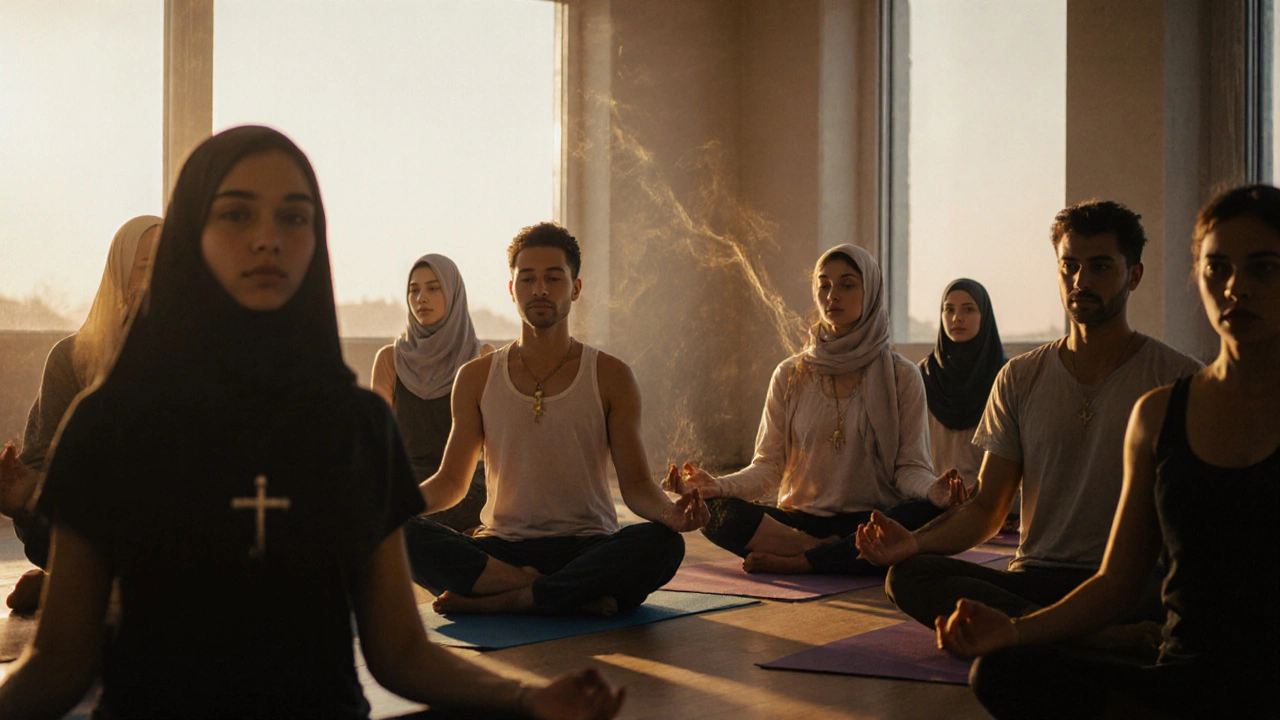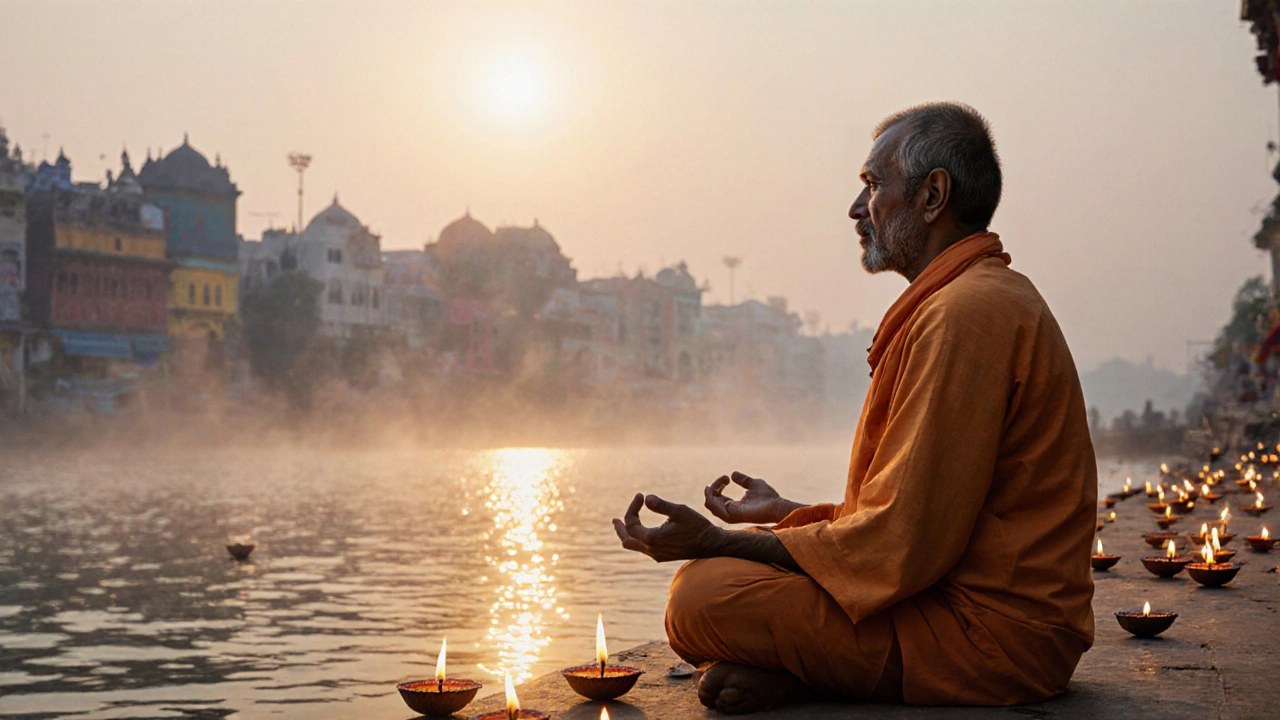Monotheism in Yoga Quiz
How Well Do You Understand One God in Yoga?
Test your knowledge of monotheism concepts in yoga and spirituality. This quiz will help reinforce the key ideas from the article.
1. What does the phrase "Ekam Sat Vipraha Bahudha Vadanti" mean?
2. How does Hindu spirituality view God differently from Western monotheism?
3. What does "Ishvara" refer to in yoga philosophy?
4. According to the article, what does yoga teach about the divine?
5. What does the concept of panentheism mean in this context?
Your score: 0/5
When you hear the phrase "one God," what comes to mind? For some, it’s the God of Christianity or Islam. For others, it’s the silent force behind the breath in yoga. But in the quiet spaces of ancient Indian wisdom, the idea of one God isn’t just a belief-it’s a lived reality. This isn’t about religion as a set of rules. It’s about seeing the same light in every temple, every prayer, every still moment on the mat.
The One Behind the Many Names
In yoga and Hindu spirituality, the concept of one God isn’t new. It’s older than most organized religions. The Upanishads, written over 2,500 years ago, say it plainly: "Ekam Sat Vipraha Bahudha Vadanti"-"Truth is one; the wise call it by many names."
This isn’t a vague spiritual slogan. It’s a precise philosophical stance. The divine isn’t split into separate beings. Brahma, Vishnu, Shiva-these aren’t three gods. They’re three faces of the same unchanging reality. Brahma represents creation, Vishnu preservation, Shiva transformation. But behind them all is Brahman-the formless, endless, infinite consciousness that is the source of everything.
Think of it like sunlight. You see it as a sunrise, a midday glow, a golden sunset. But it’s still the same sun. In the same way, the divine appears as different deities because humans need different ways to connect. But the energy behind them? One. Unbroken. Undivided.
Yoga as a Path to the One
Yoga doesn’t ask you to worship a god outside yourself. It asks you to realize the divine within. Patanjali’s Yoga Sutras, the foundational text of classical yoga, doesn’t mention gods in the way most religions do. Instead, it speaks of Ishvara-a special purusha, a pure consciousness untouched by suffering, karma, or desire. Ishvara isn’t a person. It’s the sound of Om, the vibration of the universe.
When you chant Om during yoga, you’re not calling out to a distant deity. You’re tuning your mind to the frequency of the one reality. That’s why yogis don’t need statues or altars to feel connected. They feel it in the pause between breaths, in the silence after a long hold in Warrior II, in the stillness after meditation.
Modern yoga teachers often skip this part. They focus on flexibility, poses, Instagram-worthy sun salutations. But the original purpose? To dissolve the illusion of separation. To realize that the soul inside you and the soul in the tree outside your window are made of the same stuff. That’s monotheism-not as a doctrine, but as an experience.
How Monotheism Differs in Indian Spirituality
Most Western monotheistic religions see God as separate from creation. God made the world, rules it, judges it. In Indian spirituality, God is the world. The river, the mountain, the ant crawling on your yoga mat-all are expressions of the same divine energy.
This isn’t pantheism, where God equals nature. It’s panentheism: God is in everything, but also beyond it. Like the ocean and its waves. The waves are made of water, but they’re not the whole ocean. Similarly, every form you see is a wave of Brahman, but Brahman is more than all forms combined.
This view changes everything. It means you don’t need to ask God for help. You don’t need to beg for forgiveness. You need to wake up. To stop seeing yourself as separate. To realize you’ve never been apart from the one.

Why This Matters Today
In a world full of division-religious wars, cultural clashes, identity politics-the idea of one God isn’t just poetic. It’s urgent. When you believe in one God, you can’t hate someone who calls that same God by a different name. You can’t look at a Muslim, a Christian, or a Sikh and think they’re worshipping something else. You see the same light.
That’s why so many spiritual seekers in Toronto, London, or Sydney-people raised in monotheistic traditions-are turning to yoga. Not because they’re rejecting their roots, but because they’re finding what was always there: a deeper, quieter truth beneath the dogma.
One woman I met last year in a yoga class here in Toronto grew up Catholic. She said she always felt God was far away, judging her. Then she started meditating. "I stopped praying to God," she told me. "I started listening to what was already inside me. That’s when I realized-God wasn’t out there. I was the temple."
Who Believes in Only One God?
It’s not just the monks in Varanasi or the sages in the Himalayas. It’s you. Every time you pause before reacting to anger. Every time you feel peace in nature without needing to name it. Every time you sit quietly and feel the breath move through you without labeling it as "spiritual"-you’re touching the one.
You don’t need to change your religion. You don’t need to wear saffron robes or chant in Sanskrit. You just need to stop dividing. Stop thinking God is only in the church, the mosque, or the temple. God is in the silence between your thoughts. God is in the way you hold your child’s hand. God is in the way you choose kindness over judgment.
That’s the real practice. Not the pose. Not the chant. The realization that there is only one.

What This Means for Your Daily Life
Living with the awareness of one God doesn’t mean you stop going to church or stop saying prayers. It means you change what you’re praying for. Instead of asking for wealth, health, or success, you start asking: "Help me see the one in this moment. Help me not forget."
Try this simple practice: Every morning, before checking your phone, sit for two minutes. Breathe. Notice the air entering your nose. Feel your heart beat. Ask yourself: "Is this separate from the divine?" Then let the answer come-not as a thought, but as a feeling. Most days, you’ll feel nothing. That’s okay. On the days you feel a quiet warmth, a sense of belonging-you’ve touched the one.
This isn’t about becoming perfect. It’s about becoming present. And presence is the only true worship.
Common Misunderstandings
Some people think believing in one God means rejecting all other beliefs. That’s not it. You can honor Krishna, Jesus, Allah, or the Buddha-and still know they’re all expressions of the same truth. It’s like saying the same song in different keys. The melody is unchanged.
Others think it’s a passive belief. But it’s not. It’s the most active practice there is. It means choosing compassion over anger, not because you’re told to, but because you see the same soul in the person who hurt you. It means seeing your own suffering as part of the same flow as everyone else’s.
And it’s not for everyone. Some people need the structure of separate gods, rituals, and rules. That’s fine. But if you’ve ever felt a pull toward stillness, toward unity, toward something deeper than belief-then you’re already walking this path.
Is monotheism the same in Hinduism as in Christianity or Islam?
No. In Christianity and Islam, God is usually seen as a separate, personal creator who exists outside the world. In Hindu spirituality, the one God-Brahman-is not separate from creation. Everything you see, feel, or experience is a manifestation of that one consciousness. It’s not a being you worship from afar-it’s the ground of your own being.
Can I believe in one God and still practice yoga without changing my religion?
Absolutely. Yoga is not a religion. It’s a system for quieting the mind and experiencing deeper awareness. Many Christians, Muslims, Jews, and atheists practice yoga without conflict. You don’t need to abandon your faith to realize the divine is not limited to one name or form. Yoga helps you see the unity behind all spiritual paths.
Why do Hindus worship many gods if they believe in only one?
The many gods are like different doors to the same house. Each deity represents a quality of the one divine-love, strength, wisdom, compassion. Worshipping Ganesha isn’t worshipping a separate god. It’s focusing your mind on the energy of removal of obstacles. Worshipping Lakshmi isn’t asking for money-it’s tuning into the energy of abundance. The forms help the mind focus, but the goal is always the same: to realize the one behind all forms.
Does yoga teach that God is inside me?
Yes, but not in the way most people think. Yoga doesn’t say "God lives inside you" like a little angel in your chest. It says your true self-your deepest awareness-is not separate from the universal consciousness. You are not a soul with God inside you. You are God experiencing itself as a human. The practice of yoga is about removing the layers of thought, fear, and identity that make you forget that.
Is believing in one God the same as being spiritual but not religious?
Not exactly. Being "spiritual but not religious" often means rejecting structure altogether. Believing in one God, as taught in yoga and Vedanta, is deeply structured-it’s based on ancient texts, disciplined practice, and direct experience. It’s not about rejecting religion. It’s about going beyond the surface of religion to find the shared truth beneath it.
Where to Go From Here
If this resonates, start small. Read one verse from the Bhagavad Gita each morning. Try a 5-minute meditation before bed. Notice how often you label things as "good" or "bad"-and ask if that separation is real, or just a habit of the mind.
You don’t need a guru. You don’t need a retreat. You just need to be willing to pause. To look beyond the names. To feel the silence between thoughts. That’s where the one lives.
